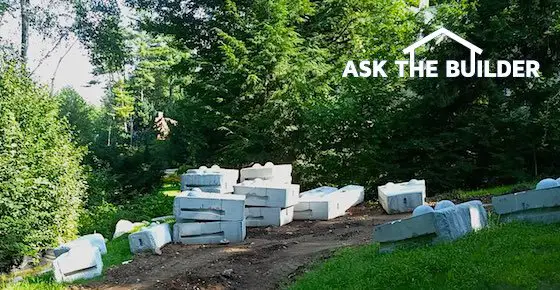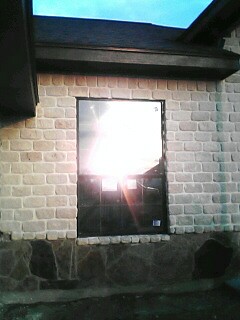
Above Ground Tornado Shelter | You can use giant precast concrete blocks like this to make an above ground tornado shelter.
Above Ground Tornado Shelter
A tornado shelter is a good thing to have if you live in many USA states. If you look at photographs and video of extreme damage caused by strong tornados, you know you that preventing serious injury or death is a matter of luck if you try to shelter inside a normal home. Large tornados can pick up semi-trailers and smash them against you or your home. Swirling 2x4s become giant arrows that can pass right through your body. Watch this short video
There are two types of tornado shelters:
- above ground tornado shelter
- underground tornado shelter
There are pros and cons to each one. Let's compare each one.
Sheltering Above Ground
Pros:
- less expensive to build in some instances
- easier and faster to get into at the last minute
Cons:
- must be extremely strong to survive a direct hit from an F4 or F5 tornado
- requires placement on a concrete slab
In Ground Tornado Shelter
Pros:
- much safer even if door is swept away
- pre-built concrete or fiberglass units can be set in one day
Cons:
- Dangerous to get into if the tornado is upon you
- Subject to ground-water infiltration
- Possibility of being trapped if debris covers the door
Garage Tornado Shelter
A garage can be a great place to locate a tornado shelter because most garages have concrete floors. Your shelter is going to be made using concrete block for the walls and it will have a concrete roof. This kind of weight requires the shelter to have a concrete floor.
Tornado Shelter Cost
A tornado shelter is going to cost you thousands of dollars. There are kits that can be bolted together that cost just under $10,000 in 2022. Inflation is raging at this time and the cost will just go up.
DIY Tornado Shelter
If you have skills and can lay concrete block, you can build your own tornado shelter using concrete block, and concrete. These materials are cheap and you might only have to spend $1,000, or less, to have a substantial shelter. It all depends on the size you choose to build. Building tips are below.
If you are in the planning stages of building a new home, you can incorporate a safe place to hide from tornadoes and hurricanes if you are willing to part with about 40-60 square feet of floor space and about $9,500. If you are the slightest bit handy, you can get the cost down to less than $1,000 (2022 figures). A custom tornado shelter can run well over $25,000 if you want lots of creature comforts and two or three alternative escape exits from the shelter.
Tornado Shelter Underground
Dreadful tornados can blow against your house for as little as 20 seconds (a fast moving tornado) or they can last for minutes (a creeping hurricane). In either case, a family of five people can huddle in a 4-foot by 8-foot shelter for this time period with an acceptable degree of comfort. If you feel you need more room, then plan for it now. The shelter can be a below-ground tornado shelter in a basement.
Above Ground Tornado Shelter Failure
The biggest thing you need to worry about is how you'll get out of the shelter once the storm has passed. It's possible the door to the shelter can be damaged making it inoperable. Some pre-built shelters have alternate escape panels you might be able to open and crawl out of.
Tornados are Giant Blenders
Watch several videos of tornados that were shot at close-up range and you can see they resemble giant food blenders. But instead of chunks of ice cubes, bananas, and strawberries that will become a smoothie, a tornado lifts up 6,000-pound trucks and cars, entire roofs, and starts to swirl these round and round at 100+ mph. Imagine a Ford Super Duty F-250 4x4 truck crashing against your above-ground tornado shelter at 150 mph. Do you now understand why you need to have a substantial shelter and a way to get out if the door is damage?
Tornado Shelter Building Tips
Solid Walls and Ceiling
Tornadoes and hurricanes lift debris into the air and transport it at great speeds. A seemingly harmless 2x4 can become a missile. Cars, brick, concrete block can all be easily lifted into the air and carried for significant distances. To protect against impact of heavy objects like this, your shelter needs to be solid. Hollow concrete block simply won't do. What's more, the block walls need to be steel reinforced. An 8 inch concrete block structure that has steel bars in the cores at 16 inches on center and has all of the cores filled with a pea gravel mix of concrete is incredibly strong. Top this off with a 4 inch thick poured concrete roof that is also steel reinforced and you have a great place to hide from storms.
Pin Things Together
You need to secure the concrete block walls to the concrete floor/slab and the roof of the shelter needs to be tied to the walls. You do this by inserting steel rods in the wet concrete. The rods in the floor slab need to extend up about 2 feet and be placed so they hit the centers of the block cores. This takes some precise layout work. The steel for the roof needs to be placed into the wet pea gravel concrete that fills the top courses of the concrete block walls.
A Sliding Door
The door to the shelter needs to slide. A hinged door can be sucked off its hinges. The best door would be one that has a solid barn door track and fits into a pocket built into the block. It needs to have a restraining bracket at the bottom corners of the door as well. This keeps the door from blowing in or out due to extreme wind pressures. The door can be made from two sheets of 3/4 inch plywood screwed together and covered with minimum 14 gauge metal sheeting. It doesn't have to look pretty. This door and how it stays in place during the storm is critical. If you can't figure it out, then ask an experienced carpenter to assist you with this job.
The Roof
The inside height of the entire structure needs to only be 7 +/- feet tall. This allows the overall height to easily fit under roof trusses that are placed on standard height walls. This is the hardest part of the job as you will need to lift about 15 five gallon buckets of concrete up onto the temporary form that supports the roof!
For information on a special underground tornado - storm shelter, visit and read this column.
Companion Articles: Metal Connectors Minimize Wind / Storm Damage, Fight Hurricane & Tornado Storms with Metal Connectors, Underground Tornado Storm Shelter, Tornado & High Wind Damage
Column B269



